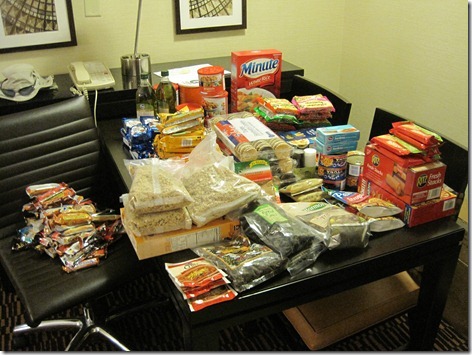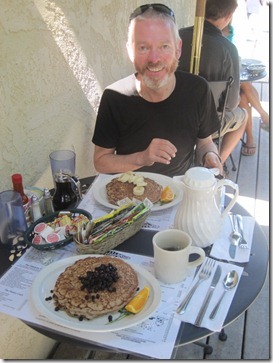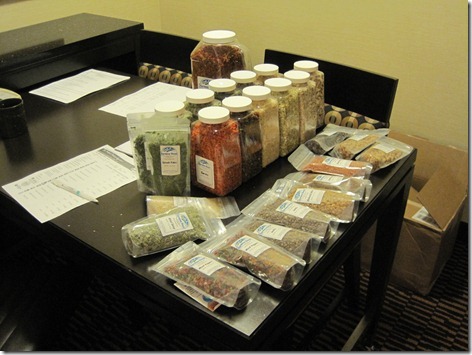Here are 11 random thoughts as to food items that featured in our PCT trip:
1) Chocolate
Chocolate is a must on any of our long walks! Choice in the US was disappointing (particularly compared to the hundreds of branded and unbranded options that there are in the UK), but we could get Snickers, Kit Kat, Twix, M&Ms, Reeces and Hersheys. All of those came at a huge price, and Hersheys was out of the question anyway as (in my opinion) it’s the most disgusting excuse for chocolate known to man. Fortunately, we mainly bought M&Ms, which were available in huge packets, but we did also get some Snickers and KitKats.
M&Ms have the benefit of a sugar shell, but we soon realised quite how badly Snickers and KitKats fare in the desert, being solid only in the middle of the night. Snickers as pre-breakfast, at 4am, didn’t go down too well!
Later in the trip, I came to discover that eating a KitKat in the middle of the day was possible if using a spoon. It’s the only time I’ve ever eaten a KitKat with a spoon, and it was a surprisingly good experience!
2) Oreo Cakesters
Oreo Cakesters (they look like oversized Oreos, but the chocolatey bits are made out of cake rather than biscuit) are good! And they even taste nice when completely mashed, which is a good thing, as they really don’t travel well!
3) Pints of Ice-Cream
Obviously not something that we popped into our backpacks, but there’s nothing nicer than walking into a town, in approaching 40 degree temperatures, and to feel no guilt whatsoever in destroying an entire pint of ice cream.
4) Biscuits (or Cookies if you’re American)
In our original resupply shop in Los Angeles we really struggled to find things for puddings. The item that we found, which not only offered an excellent calorie to weight ratio but were also available at a reasonable price, was big 1kg packets of biscuits (think Oreos, but some were half chocolate half plain, and some were entirely plain). Fourteen biscuits fitted nicely, as two stacks, into a ziplock bag and they travelled really well. We did, perhaps, buy too many (mainly as they were one of the only items we found that wasn’t outrageously expensive) as, by the end of the trip, Mick couldn’t even bear to look at them. That said, I think that every single one got eaten.
5) Granola
On UK backpacking trips, breakfast is usually muesli or granola and sometimes porridge, but interspersed with a cooked breakfast in a greasy spoon or a B&B when the opportunity arises. On the PCT, in the absence of greasy spoons and B&Bs, granola featured heavily. Even though we had a good variety of flavours, by the end of the trip neither of us ever wanted to see a spoonful of the stuff ever again. In fact, there’s a box of muesli sitting in the cupboard at home that’s about to go out of date because we still can’t even bear muesli; must make it into some flapjacks to save wastage!
All foods mentioned in this post, except for the ice-cream, are on that table and chair.
6) Gatorade
I attribute no small part of the success of this trip on Gatorade! It’s available in US supermarkets in powdered form and we drank one bottle with breakfast, one with our evening meal and sometimes (if we had enough powder) one with lunch too. Extra calories, a very pleasant change to plain water, and allegedly good for electrolyte balance when walking in such a hot place. We ended up throwing all of our tea bags away, as the Gatorade took the place of our usual cups of tea.
7) Stock Cubes
I’m so pleased that I took along a selection of stock cubes as, when I finally remembered that we had them with us, they did improve our meals.
8) Olive Oil
Olive oil was carried purely for the extra calories. We didn’t need as much as we carried, as we kept forgetting to use it, but once I did get into the swing of adding a glug to every meal it worked out fine.
9) Minute Rice
Why can’t we get Minute Rice (an instant cooked, dried rice) in supermarkets in the UK? Surely there must be a market for it? If we could, then I really don’t think that I would go to the bother of cooking and dehydrating my own.
10) Fish & Biscuits! (and a mention of Noodles)
We didn’t get our trail names for nothing, as fish and crackers featured quite a bit in our diet. In fact, more than usual, as the opportunities to buy cheese were so limited. The fish options were good. I clearly remember the joy of kippers and oat cakes, which seemed somewhat out of place as a meal to have in the desert! Noodles also featured quite a bit, but Mick ended up eating more of them than me, as never have I had such bad and long-lived indigestion as when I had noodles for lunch (don’t know why; I’ve eaten noodles since with no issues).
11) Food Shopping In General
What really surprised us about the food was the price of it. Eating out was cheap, yet supermarket shopping was expensive and (in some product lines) surprisingly lacking in choice. I can see why eating out is so popular over there – it’s just a pity that there were so few (well, strictly speaking, none) restaurants on our route.





























